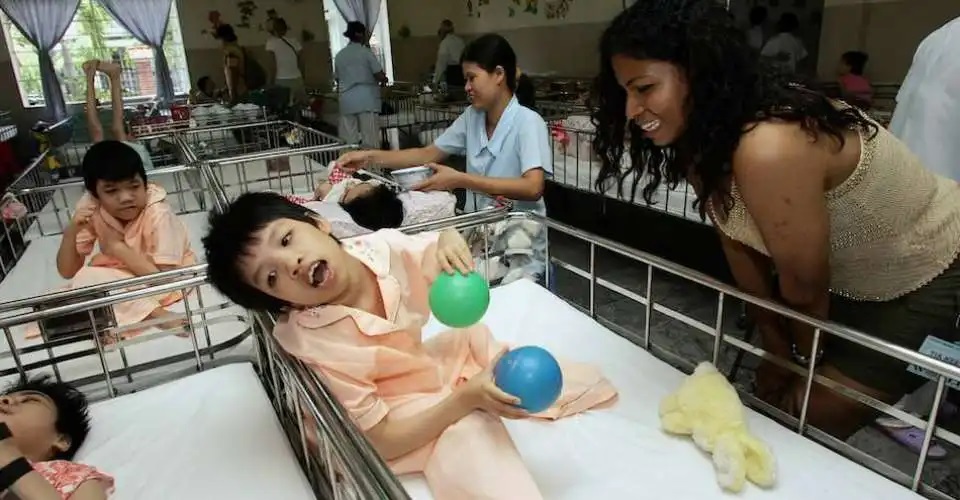The tragic heroes of Vietnam's 'Operation Babylift' plane crash
Fifty years ago, two Australian Catholic nurses died in an air tragedy trying to save orphans before the fall of Saigon
Apr 28, 2025

By Terry Friel
Fifty years ago this month, two Australian Catholic nurses, Margaret Moses and Lee Makk, from the Adelaide Sisters of Mercy boarded a US Air Force C-5A Galaxy aircraft carrying more than 300 Vietnamese children, nurses and crew in Operation Babylift to evacuate orphans as the North Vietnamese overran Saigon.
They never made it. Nor did many of the children.
A cargo door blew out shortly after take-off from Saigon’s Tan Son Nhut Air Base, damaging the aircraft's controls.
The pilots desperately tried to return to the airfield, but the plane crashed just short of the runway, breaking into pieces and engulfed by flames, killing 138 of those on board.
“The news stunned us,” says 90-year-old Ruth Egar, a Sisters of Mercy nurse, who knew the nurses from their time at the Sisters of Mercy in Adelaide.
“We were numb with grief and fear — grief for all who had died and fear for the others still there,” said the nun, who went to Saigon at the age of 40.
The two nurses were among several others, called “The Angels of Heaven,” who volunteered to serve in Vietnam in the military and with religious groups.
Nurses were vital — there were very few Vietnamese doctors because they had been called up to the military. The mortality rate for children, particularly orphans, was extremely high.
The two Australian nurses had gone to Saigon in 1971 to work with another Sister of Mercy from Adelaide, Rosemary Taylor, who ran a series of orphanages in rented houses for the American charity Friends of the Children of Vietnam.
By 1975, after decades of war and with the imminent fall of Saigon, now officially Ho Chi Minh City, a humanitarian crisis was sweeping South Vietnam.
As the North Vietnamese army took more and more southern cities, South Vietnamese citizens began to flee en masse.
Margaret, 35, her mother and Lee, who was born Gyoparka Maria Makk in Hungary in 1945, were to have been on a Royal Australian Air Force C-130 Hercules taking children to Australia via the RAAF airbase in Butterworth in Malaysia. Margaret’s mother did leave safely on one of those RAAF aircraft.
But a USAAF Galaxy bound for the United States was short of escorts for the children, so Margaret and Lee volunteered to go with babies for the long flight via Guam.
Rosemary Taylor later wrote that Margaret's organizational talents, eloquence, sense of humor, and command of French were invaluable in dealing with everyone from plumbers to politicians, military police to milk vendors.
Margaret often put down her thoughts and fears in letters and poetry. One line, published in the 1976 anthology “Turn my eyes away: Our children in Vietnam 1967 to 1975,” edited by Taylor, read:
“I never got over the horror of children who had never lived, dying.”
“We could do nothing but hope and pray, and wait for more news.
The work was tough, unrelenting and dangerous, but rewarding, Egar says now.
“We went, knowing that in Australia the fears of the war — and it being lost — were rife.
“Many were working day and night with those babies, including Vietnamese women whose husbands and sons were at war.
“They gave their all and refused to allow the sentiments of politics to become part of their interests.
“I was a trained nurse and more than anything, nurses were needed for the many orphaned and near-to-death babies who were brought in every day.
“I think I did provide a boost, if not to their morale, they were intrigued by this ’blow-in’ from Australia, whose comments provided great laughter.
“There was joy — because someone else had come and was willing to pitch in.”
US President Gerald Ford initiated Operation Babylift on April 3, 1975, with the help of allies such as West Germany, France, Canada and Australia.
It remains the largest organized evacuation of children in modern history.
The Sisters of Mercy, which has sent missionaries to some of the most dangerous places in the world, was founded by Catholic laywoman Catherine Macaulay in Dublin in 1831.
They spread to Australia in 1846, then to Papua New Guinea in 1956. The Australian arm is now known as the Institute of the Sisters of Mercy Australia and Papua New Guinea, after the several branches in Australia and PNG merged in 2011.
In addition, traditional pastoral work, the Institute of Sisters of Mercy Australia and Papua New Guinea now advocate for indigenous Australians, refugees and asylum seekers, women’s rights in PNG, the environment and against human trafficking.
They also provide counselling, run meditation retreats and teach music, speech and drama.
Organizations such as the Sisters of Mercy, Catholic Relief Services, World Vision, and other missionary orders, such as the Franciscan Sisters, saved thousands more in the years before 1975.
Operation Babylift saved about 3,000 orphans in less than four weeks in April 1975, according to various official estimates.
“They were for me, really happy days,” says Egar of her time in the orphanages of Saigon.
“And the dying babes asked each of us our full attention and nursing support — and love.”--ucanews.com







Total Comments:0